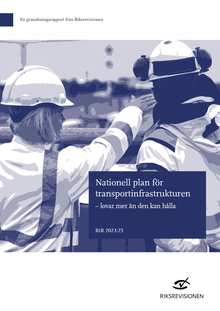Major shortcomings in long-term infrastructure planning
The Government has compromised long-term infrastructure planning through its management of the Swedish Transport Administration. The Swedish Transport Administration’s weak cost control has exacerbated the situation. This has led to decreased mobility and more road deaths than would otherwise have been possible.

Photo: Plattform
In its national plan for transport infrastructure, the Government has established which major infrastructure projects are to be implemented in 2022–2033. The budget for the major projects is about SEK 300 billion.
The overall conclusion of the Swedish National Audit Office is that the Government’s chosen investments do not effectively contribute to achieving the Riksdag’s transport policy objectives.
The shortcomings are due in part to the fact that the Government, in its management, has not given the Swedish Transport Administration the means to propose the projects that have the most efficient cost-benefit ratio. Together with major cost increases, this has hampered planning that gives the best value for the money.
“The Swedish planning model provides essentially sound prospects for devising infrastructure policy that effectively contributes to achieving the Riksdag’s objectives. This model was compromised by the Government’s management and the Swedish Transport Administration’s weak cost control,” says Auditor General Helena Lindberg.
The investment budget for the national plan for 2022–2033 was higher than ever before. However, the cost increases for investments such as the previously decided new main lines meant that there was hardly any money for new projects.
The Government also instructed the Swedish Transport Administration to include parts of the North Bothnia Line in the proposal for a national plan, despite the lack of documentation about costs and benefits. The investment could not be accommodated within the available budgetary framework. All in all, the financial frameworks for infrastructure investments were thereby reserved long after the end of the planning period in 2033.
The Swedish Transport Administration’s possibilities to propose investments were also severely limited by the Government’s instruction for the previous plan from 2018 to be pursued to completion. The Swedish Transport Administration has therefore not been able to reconsider the investments that became much more costly, or the investments where the expected benefits had decreased.
“In the early stage of the national plan, many investments were rejected that would have contributed much more to fulfilling the transport policy objectives and, for example, provided better travel and transport opportunities and fewer road deaths,” says Magnus Landergren, project leader for the audit.
The Government has also chosen to reduce appropriations to the new railway signal system, ERTMS, even though the Swedish Transport Administration warned that this posed “a direct systemic threat”. According to the Swedish Transport Administration, ERTMS will thus not be implemented until after 2070, leading to a substantial increase in maintenance costs for the old system.
Recommendations in brief
The recommendations to the Government include the following:
- Clarify how the adoption of the national plan deviates from the Swedish Transport Administration’s proposal, and explain why.
- Discontinue, to a greater extent, investments when conditions for implementation have deteriorated, provided that construction on the project has not started.
- Give the Swedish Transport Administration greater scope to design its plan proposal.
It is recommended that the Swedish Transport Administration give priority to investments with a high cost-benefit ratio in its proposal for a national plan.
See the report for the full recommendations.
Facts National plan for transport infrastructure
The purpose of a national plan is to provide long-term conditions for infrastructure investments, which require very long planning horizons. The Riksdag sets a financial framework for a 12-year planning period and the Government chooses which investments are to be included after receiving proposals and documentation from the Swedish Transport Administration. The Swedish NAO’s audit focuses mainly on the national plan for 2022–2033.
Press contact: Olle Castelius, phone: +46 8-5171 40 04.
Presskontakt: Olle Castelius , telefon: 08-5171 42 06.
Share in social media and by e-mail
Contact form
Send your questions or comments via the form below and we will make sure that they reach the right member of staff. Please state if your question concerns the information on this particular page.


